Acetate-mediated novel survival strategy against drought in plants ($)
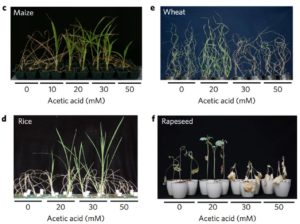 Kim et al. explored the molecular basis for the drought tolerance previously observed for mutants of histone deacetylase HDA6. They observed that genes involved in acetate production are upregulated in hda6 mutants and in drought-stressed plants. Furthermore, acetate biosynthesis mutants are more sensitive to drought, indicating a role for acetate in drought tolerance. Finally, they showed that applying low concentrations of acetic acid to various plants enhanced their tolerance to drought. Their data suggest that this effect is mediated through the jasmonic acid signaling network. Nature Plants 10.1038/nplants.2017.97
Kim et al. explored the molecular basis for the drought tolerance previously observed for mutants of histone deacetylase HDA6. They observed that genes involved in acetate production are upregulated in hda6 mutants and in drought-stressed plants. Furthermore, acetate biosynthesis mutants are more sensitive to drought, indicating a role for acetate in drought tolerance. Finally, they showed that applying low concentrations of acetic acid to various plants enhanced their tolerance to drought. Their data suggest that this effect is mediated through the jasmonic acid signaling network. Nature Plants 10.1038/nplants.2017.97


 Samodelov and Zurbriggen describe approaches to exquisitely fine-tune protein and metabolite expression levels through a variety of synthetic and semi-synthetic biology approaches. For example, optigenetics tools enable gene expression to be activated precisely via a light beam; when combined with downstream regulators including miRNAs and inducible protein degradation tags, the gene product can be reliably switched off as well as on. Similarly, the authors review efforts to use synthetic biology to optimize biosensors (transcriptional, degron, or FRET based) that read out spatially resolved and quantitatively sensitive levels of hormones or metabolites, as well as efforts to mathematically model plant processes based on the collected data. One of the outstanding questions raised by the authors is “How can the novel theoretical–experimental concepts of synthetic and quantitative plant biology best be incorporated into teaching curricula to prepare future generations of plant researchers for the challenges ahead?” – this review is a good place to start. Trends Plant Sci.
Samodelov and Zurbriggen describe approaches to exquisitely fine-tune protein and metabolite expression levels through a variety of synthetic and semi-synthetic biology approaches. For example, optigenetics tools enable gene expression to be activated precisely via a light beam; when combined with downstream regulators including miRNAs and inducible protein degradation tags, the gene product can be reliably switched off as well as on. Similarly, the authors review efforts to use synthetic biology to optimize biosensors (transcriptional, degron, or FRET based) that read out spatially resolved and quantitatively sensitive levels of hormones or metabolites, as well as efforts to mathematically model plant processes based on the collected data. One of the outstanding questions raised by the authors is “How can the novel theoretical–experimental concepts of synthetic and quantitative plant biology best be incorporated into teaching curricula to prepare future generations of plant researchers for the challenges ahead?” – this review is a good place to start. Trends Plant Sci. 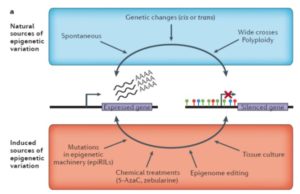 Variation provides the raw material for selection and improvement. Springer and Schmitz describe how natural and induced epigenetic variation supplements genetic variation. This review starts with a description of epigenetics, epigenomics (the genome-wide distribution of epigenetic information), and the origin and maintenance of epigenetic marks. Epigenetic variation can arise spontaneously but also from chemical treatments that affect DNA methylation, wide-crosses (between distant relatives), and tissue culture. The authors highlight the potential of targeted epigenetic engineering as a new approach for crop improvement. Nat. Rev. Genet.
Variation provides the raw material for selection and improvement. Springer and Schmitz describe how natural and induced epigenetic variation supplements genetic variation. This review starts with a description of epigenetics, epigenomics (the genome-wide distribution of epigenetic information), and the origin and maintenance of epigenetic marks. Epigenetic variation can arise spontaneously but also from chemical treatments that affect DNA methylation, wide-crosses (between distant relatives), and tissue culture. The authors highlight the potential of targeted epigenetic engineering as a new approach for crop improvement. Nat. Rev. Genet. 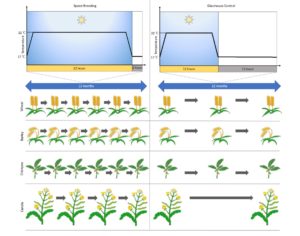 Watson and Ghosh et al. describe protocols to accelerate the lifecycle of several crop species using “speed breeding”, which essentially involves extending the daylength to 22 hours with supplemental lighting. They describe methods and results from glasshouse and growth chamber speed breeding. In spite of greatly shortened generation times, seed production was similar for the conventional and accelerated plants, making this a promising approach with which to develop new varieties. bioRxiv
Watson and Ghosh et al. describe protocols to accelerate the lifecycle of several crop species using “speed breeding”, which essentially involves extending the daylength to 22 hours with supplemental lighting. They describe methods and results from glasshouse and growth chamber speed breeding. In spite of greatly shortened generation times, seed production was similar for the conventional and accelerated plants, making this a promising approach with which to develop new varieties. bioRxiv 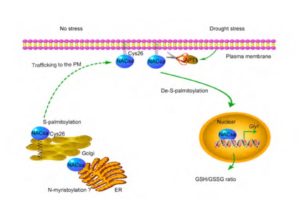 Regulation of transcription factor (TF) localization is a common strategy for gene expression regulation. Wang et al. identified a membrane-anchored TF, MfNACsa, as contributing to drought stress responses. In unstressed plants, MfNACsa is anchored to the plasma membrane through covalent-attachment of a palmitic group (a fatty acid) to a cysteine (known as S-palmitoylation). Upon drought stress, MfNACsa is de-S-palmitoylated by a thio-esterase, permitting its translocation to the nucleus. There, it induces expression of stress-responsive genes including Gly1, which is involved in glutathione homeostasis during drought. Plant Cell
Regulation of transcription factor (TF) localization is a common strategy for gene expression regulation. Wang et al. identified a membrane-anchored TF, MfNACsa, as contributing to drought stress responses. In unstressed plants, MfNACsa is anchored to the plasma membrane through covalent-attachment of a palmitic group (a fatty acid) to a cysteine (known as S-palmitoylation). Upon drought stress, MfNACsa is de-S-palmitoylated by a thio-esterase, permitting its translocation to the nucleus. There, it induces expression of stress-responsive genes including Gly1, which is involved in glutathione homeostasis during drought. Plant Cell 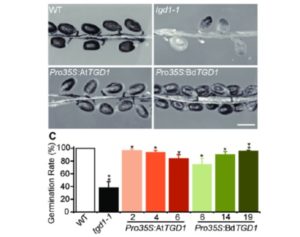 Sometimes, when a science experiment doesn’t work out,
Sometimes, when a science experiment doesn’t work out, 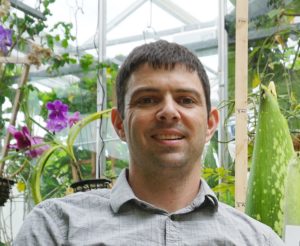 This week’s post was written by Dr Ian Street (
This week’s post was written by Dr Ian Street (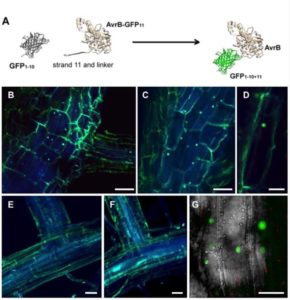 Bacterial effectors are proteins produced by bacteria and introduced into their hosts, where the effectors support successful infection by the pathogen. Effectors can function in diverse cells and cell compartments, but many studies of effector localization have relied on overexpression systems which may have artifacts. Henry et al. used the GFP strand system to visualize effector delivery during natural infection. In this system, plants are stably transformed with a gene encoding most but not all of the GFP protein, and the infecting bacteria express their effectors fused to the missing strand of the GFP structure. The GFP self-assembles in vivo, leading to fluorescence where the effector is delivered. This robust system revealed distinct effector localizations for various effectors and bacteria. Plant Cell
Bacterial effectors are proteins produced by bacteria and introduced into their hosts, where the effectors support successful infection by the pathogen. Effectors can function in diverse cells and cell compartments, but many studies of effector localization have relied on overexpression systems which may have artifacts. Henry et al. used the GFP strand system to visualize effector delivery during natural infection. In this system, plants are stably transformed with a gene encoding most but not all of the GFP protein, and the infecting bacteria express their effectors fused to the missing strand of the GFP structure. The GFP self-assembles in vivo, leading to fluorescence where the effector is delivered. This robust system revealed distinct effector localizations for various effectors and bacteria. Plant Cell 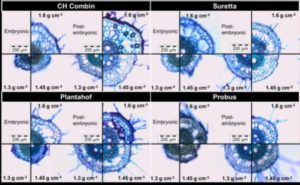 We live at a time of unprecedented insights into root anatomy, diversity, plasticity, and the genetic underpinnings of these traits. Colombi et al. examined how wheat root tip shape contributes to soil penetration and the root’s response to increasing soil density. Not surprisingly, pointier roots (with a lower ratio of tip diameter to tip length) penetrate soils more effectively than blunter roots. The authors also observed genotypic differences in root tip shape and root elongation rate, and responses to increasing soli density. These results provide another selectable root trait for future breeding projects. Plant Physiol.
We live at a time of unprecedented insights into root anatomy, diversity, plasticity, and the genetic underpinnings of these traits. Colombi et al. examined how wheat root tip shape contributes to soil penetration and the root’s response to increasing soil density. Not surprisingly, pointier roots (with a lower ratio of tip diameter to tip length) penetrate soils more effectively than blunter roots. The authors also observed genotypic differences in root tip shape and root elongation rate, and responses to increasing soli density. These results provide another selectable root trait for future breeding projects. Plant Physiol.